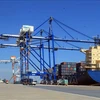Thai opposition protesters led by the People’s Democratic Reform Committee on January 13 launched their planned "shutdown" of Bangkok in an escalation of their campaign to unseat Prime Minister Yingluck Shinawatra.
The demonstrators occupied seven key intersections in the capital and gathered at strategic points in the city, including outside a major shopping mall that was set on fire during the deadly anti-government rally in 2010.
The organisers said the campaign only aims at preventing officials and government staff to enter offices and cutting off power and water supply in government’s buildings. However, many city residents are worried that the campaign will affect their daily lives.
According to the police, 12 hospitals, 28 hotels, 24 schools and five petrol stations are expected to be affected by the campaign.
They estimate that 700,000 vehicles travel through the seven planned protest sites on a normal day in the Thai capital.
Traffic was light in the city centre but the metro and sky train were still running.
The authorities say they are ready to declare a state of emergency if there is fresh unrest, and roughly 20,000 police and soldiers will be deployed for security.
To date, eight people, including a police officer, have been killed and many others injured during protests, which escalated since late October 2013. This is the worst protest since 2010 when more than 90 people were killed in street clashes.-VNA
The demonstrators occupied seven key intersections in the capital and gathered at strategic points in the city, including outside a major shopping mall that was set on fire during the deadly anti-government rally in 2010.
The organisers said the campaign only aims at preventing officials and government staff to enter offices and cutting off power and water supply in government’s buildings. However, many city residents are worried that the campaign will affect their daily lives.
According to the police, 12 hospitals, 28 hotels, 24 schools and five petrol stations are expected to be affected by the campaign.
They estimate that 700,000 vehicles travel through the seven planned protest sites on a normal day in the Thai capital.
Traffic was light in the city centre but the metro and sky train were still running.
The authorities say they are ready to declare a state of emergency if there is fresh unrest, and roughly 20,000 police and soldiers will be deployed for security.
To date, eight people, including a police officer, have been killed and many others injured during protests, which escalated since late October 2013. This is the worst protest since 2010 when more than 90 people were killed in street clashes.-VNA



















